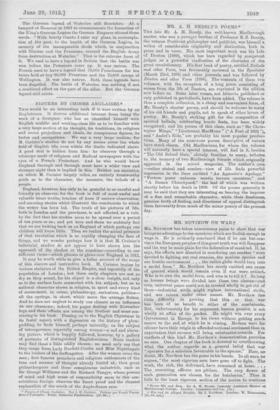FIGURES ET CHOSES ANGLAISES.*
THIS would be an interesting boa if it were written by an Englishman. It derives additional interest from being the work of a foreigner, who has so identified himself with English middle- and working-class life as to be familiar with a very large section of its thought, its traditions, its religious and social prejudices and ideals, its conspicuous figures, its tastes and occupations. We say a very large section ; for M. Cerisier's studies do not by any means cover the whole field of English life, even within the limits indicated above. A good deal is hidden from him: he observes through a telescope made of religious and Radical newspapers with the eyes of a French Protestant. And he who would know England through and through must have a wider view and stronger sight than is implied in this. Neither are statistics; on which M. Cerisier largely relies, an entirely trustworthy guide as to the character, the manners, the beliefs of a people.
England, however, has only to be grateful to so careful and friendly an observer, for the book is full of most useful and valuable home truths, touches of keen if narrow observation, and amusing stories which illustrate the conclusions to which the writer has been led. The truth of his pictures of life, both in London and the provinces, is not affected, as a rule, by the fact that his studies seem to be spread over a period of ten years or so ; and yet here and there We suddenly feel that we are looking back on an England of which perhaps our children will know little. Then we realize the actual presence Of that revolution which is so rapidly changing the face of things, and we wonder perhaps bow it is that M. Cerisier's industrial. studies do not appear to have shown him the approach of the shadow or the sunshine—according to our different views—which glooms or glows over England in 1912.
It may be worth while to give a fuller account of the Scope of this sincere and instructive book. M. Cerisier begins by Various statistics of the British Empire, and especially of the population of London ; but these early chapters are not so dry as they pound, for his object is a clear insight, not only as to the surface facts connected with his subject, but as to national character shown in religion, in sport and every kind of amusement, in crime, philanthropy, caricature, politics— all the springs, in short, which move the average Briton. And he does not neglect to study our climate as an influence on our character; indeed, his pages dealing with November fogs and their effects are among the liveliest and most con- vincing in his book. Passing en to the English Christmas in its festal aspect, with a digression on the history of plum- pudding, le finds himself, perhaps naturally, on the subject of intemperance, especially among women—a sad and alarm- ing picture, which is happily followed, however, by a gallery of portraits of distinguished Englishwomen.. Some readers may find these a little oddly chosen : we need only say that they range from Lady Burdett-Coutts and Miss Nightingale to the leaders of the Suffragettes. After the women come the men ; first famous preachers and religious enthusiasts of the tone and manner of thought already hinted at ; then great philanthropists and those conspicuous industriels, such as Sir George Williams and Sir Richard Tangye, whose powers of mind and high sense of responsibility seem to this con- scientious foreign observer the finest proof and the clearest
explanation of the worth of the Anglo-Saxon race. •
• Figures et Chosos Anglaise°. Par J. E. Cerisier. Preface par Prank Puma. Avec 6 Portraits. Paris: Librairie Fischtneher. [Ilf. 50c.]






















































 Previous page
Previous page